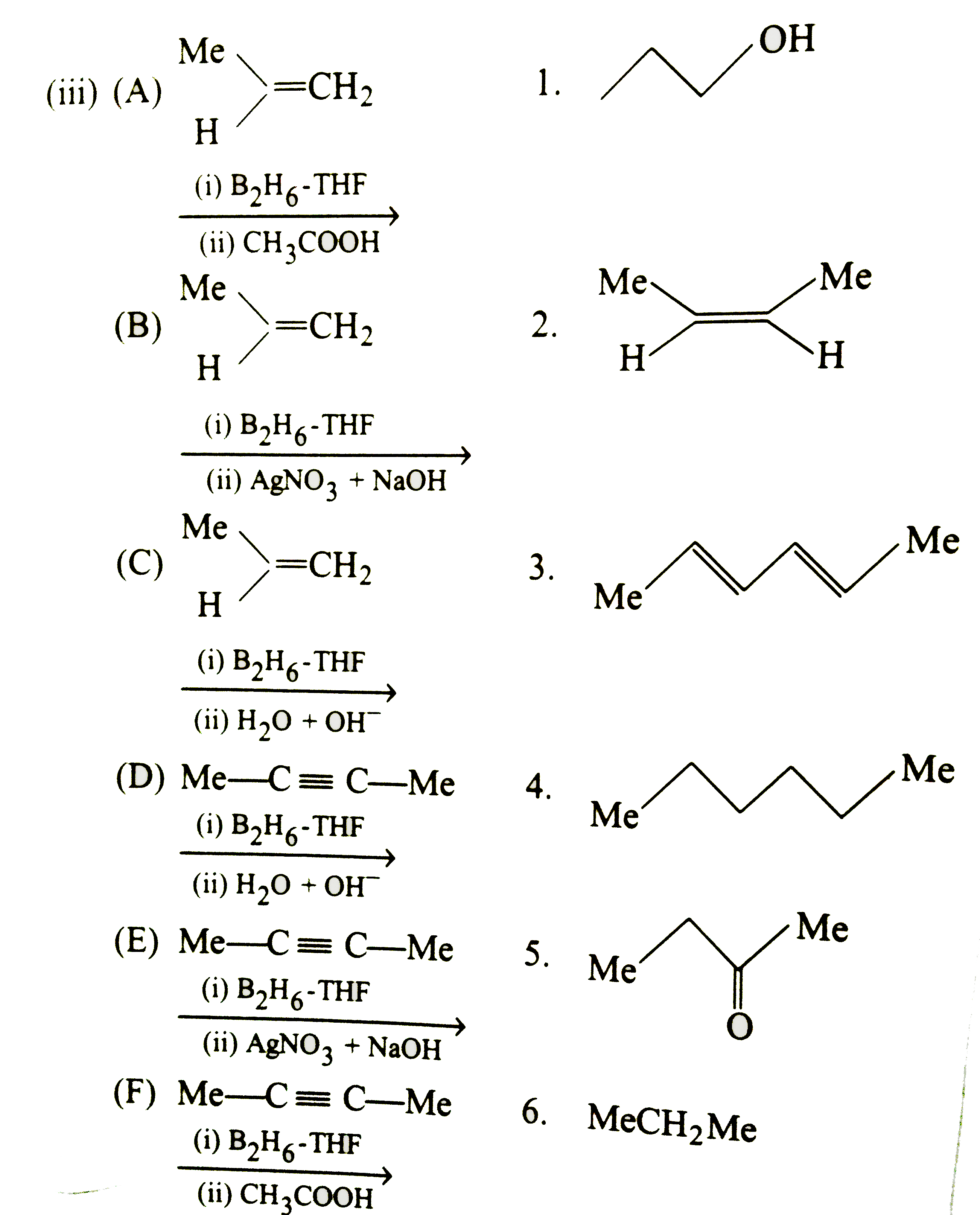Match the following :
Column IColumn II(a)Denatured spirit contains(p)CH3OH(b)Absolute alcohol contains(q)C2H5OH(c)Rectified spirit contains(r)Petrol(d)Power alcohol contains(s)4.5%water
The correct Answer is:(a-p,q); (b-q); (c-q,s); (d-q,r)
Topper's Solved these Questions
- ALCOHOLS, PHENOLS AND ETHERSBOOK - OP TANDONCHAPTER - ALCOHOLS, PHENOLS AND ETHERSEXERCISE - LINKED COMPREHENSION Passage 1
5 Videos
- ALCOHOLS, PHENOLS AND ETHERSBOOK - OP TANDONCHAPTER - ALCOHOLS, PHENOLS AND ETHERSEXERCISE - passage 2
5 Videos
- ALCOHOLS, PHENOLS AND ETHERSBOOK - OP TANDONCHAPTER - ALCOHOLS, PHENOLS AND ETHERSEXERCISE - ASSERTION-REASON
20 Videos
- ALDEHYDES AND KETONES BOOK - OP TANDONCHAPTER - ALDEHYDES AND KETONES EXERCISE - SINGLE INTEGER ANSWER TYPE QUESTIONS
10 Videos
Similar Questions
C2H5OH is base because it contains OH group .
View SolutionMatch the following :
Column IColumn IIC(Compounds)(Reagents and reactions of response)(a)Isopropl alcohol(p)Victor Meyer's reagent(b)Ethyl alcohol(q)Ceric ammonium nitrate(c)Benzyl alcohol(r)Haloform test(d)tert-Butyl alcohol(s)Lucas reagent
View Solution
Knowledge Check
Which of the following alcohol containsCsp3−OH bond?
AAllylic alcoholBVinylic alcoholCphenolsDAll of the aboveMatch the column -
Column-I Column-II
(a)Copper pyrites(P)ZnCO3(b)Malachite(Q)CuCO3.Cu(OH)2(c)Calamine(R)CuFeS2(d)Sphalerrite(S)ZnSA(a)Q (b)R (c )S (d)PB(a)R (b)Q (c )P (d)SC(a)P (b)Q (c )R (d)SD(a)S (b)P (c )R (d)Q
Match the following : Column -I Column -II (A) Addition of H2 on alkenes (p) Homogeneous catalysis(B) Hydrolysis of an organic ester (q) Heterogeneous catalysis(C) Conversion of alcohol directly into gasoline (petrol) (r) Shape selective catalysis(D) Hydrolysis of urea (s) Enzyme catalysis (t) Use of ZSM - 5
View SolutionMatch the following :
Column IColumn II(a)CH6H5CHO(p)Haloform reaction(b)HCHO(q)Fehling's solution(c)CH3CHO(r)Cannizzaro reaction(d)CH3−CO−CH3(s)Knoevenagel reaction
View SolutionMatch the following the compounds of column I with column II.
Column-IColumn-II(A)Wood spirit(p)2−Butyne(B)Acetone(q)Trichloromethane(C)Dimethyl acetylene(r)Methanol(D)Chloroform(s)Propanone
View SolutionHere each question contains statements given in two column which have to be matched. Statements in columns I are labelled as A, B, C and D where as the statements in column II are labelled p, q, r and s. The answers to these questions are to be appropriately bubbled as illustrated in the following example.
If the correct matches should like the following.

Column IColumn II(A) Hydrophosphorus acid(p)+5(B) Phosphoric acid(q) tribasic(C) Pyrophosphoric acid(r)+1(D) Metaphosphoric acid(s) mono basic
View SolutionMatch the following :
(A)Fermentation1.Secondary(B)Dynamite2.Methyl alcohol(C)Absolute alcohol3.ZnCl2+HCl(D)Glycerine4.Dihydric alcohol(E)Wood spirit5.Nitroglycerine(F)Lucas reagent6.Propane-1,2,3-triol(G)Propan-2-ol7.100%ethyl alcohol(H)Glycol8.Invertase
(ii) (A)Methylated spirit1.Elimination(B)Enzyme2.Bouveault Blanc reduction(C)C2H5OH+conc.H2SO43.Antifreeze(D)Lucase test4.Esterification(E)Glycerol5.Fenton's reagent(F)RCHONa/C2/N5OH−−−−−−−−−→6.Zymase(G)FeSO4+H2O27.Denatured alcohol(H)C2H5OH+CH3COOH in presence of H2SO48.Tertiary alcohol

View SolutionColumn I (Solvent)Column II (Nature)(A)Methyl alcohol(CH3OH)(p)Protophilic(B)Benzene(C6H6)(q)Protogenic(C)Ammonia(NH3)(r)Amphiprotic(D)Acetic acid(CH3COOH)(s)Aprotic
View Solution
